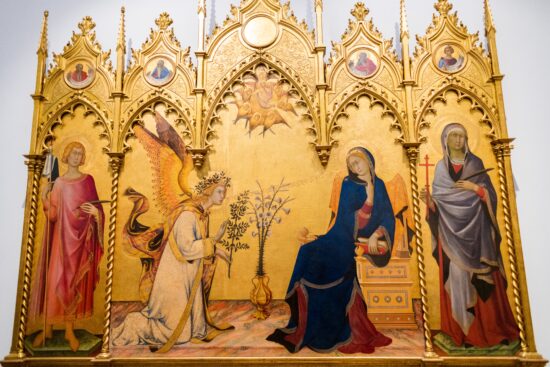
What’s Amazing about the Annunciation!
Trigger warning: sexual assault
How we experience life embodied as sexed beings affects how we read the biblical text. So how do many women do so? We do so as those who have (a) been violated ourselves or (b) as those who live in close proximity with someone who is a survivor of such violation.
According to RAINN, one out of every 6 American women has been the victim of an attempted or completed rape in her lifetime. Contrast this with the one in 33 American men who have been victims of attempted or completed rape. Women are raped more than five times as often as men. And neither of these statistics is acceptable! Yet what is sometimes left out in citing this data is the observation that in either case, nearly 99% of the perpetrators were male.
That means females are vulnerable in relation to males in a way that males are far, far less vulnerable in relation to females. This is an embodied reality for women. And this reality has theological ramifications—especially for how we might view the Annunciation, that beautiful scene where the angel announces to the virgin that she will be bear the child who will be called “Son of the Most High” (Luke 1:26–38).
Some scholars such as Mary Daly, who described herself as a “radical lesbian feminist,” saw the annunciation as rape, describing Jesus’s mother as “Total Rape Victim.”
Whoa. While most of my readers would recoil at such a statement, those looking through the eyes of sexual assault might secretly wonder how they would answer the charge that the Virgin Mary had been socialized for compliance. Those who have viewed the Amazon Prime series “Shiny, Happy People” have seen how people can be groomed for a compliance that makes them unable to resist. And how could someone resist the all-powerful God?
In her book Jesus and the Gender of God, Amy Peeler addresses such questions. In doing so, she points out that the Gospel writers themselves, operating in cultures in which gods assaulted women, appear to have been cognizant of such concerns. In fact, Peeler argues that the Gospel writers crafted their narratives to address them.
Contrast a story about Zeus with Luke’s recounting of the annunciation….
How Zeus Treats a Virgin
The Roman poet Ovid lived from 43 BC to AD 17, during the reign of Augustus. So, Ovid’s work was roughly contemporary with the earliest Christians. And in The Metamorphases II, Ovid tells of how of Jupiter—that is Zeus—sexually assaults the nymph Callisto:
The sun was high, just past the zenith, when [Callisto] entered a grove that had been untouched through the years. Here she took her quiver from her shoulder, unstrung her curved bow, and lay down on the grass, her head resting on her painted quiver. Jupiter [Zeus], seeing her there weary and unprotected, said, “Here, surely, my wife will not see my cunning, or if she does find out it is, oh it is, worth a quarrel!”
Quickly he took on the face and dress of Diana, and said [to Callisto], “Oh, girl who follows me, where in my domains have you been hunting?”
The virgin girl got up from the turf replying, “Greetings, goddess greater than Jupiter: I say it even though he himself hears it.”
He did hear, and laughed, happy to be judged greater than himself, and gave Callisto kisses unrestrainedly—and not those that virgins give.
When she started to say in which woods she had hunted, he embraced and prevented her—and not without committing a crime. Face to face with him, as far as a woman could, she fought him. But how could a girl win, and who is more powerful than Jove?
Ovid’s is only one of several ancient stories in which gods sexually violated women. Cassandra was raped by Ajax the Lesser; Chione was violated by Hermes; Cassiopeia was sexually assaulted by Zeus in the form of her husband Phoenix.
How the Most High Treats a Virgin
Such actions look nothing like those of our God. As Peeler observes, in Luke’s description of the Annunciation, the author of the third Gospel goes out of his way to show how God differs in his treatment of women. In Luke’s telling, Mary places herself in the service of the divine one, seeing “God as the Most High.” Our God is supremely holy—the holiest.
And rather than use language that describes the Spirit (not the Father) as entering or going into Mary, Luke uses spatially “above” language—telling how the Spirit will come upon her and overshadow her. In Peeler’s words, Mary’s “body will be cultivated, but it will not be penetrated.”
Additionally, the conception event is not presented by the angel as having happened already, but rather is presented as a future event. Before Mary conceives, she gives verbal consent. And here Peeler makes two key observations: “Conception of this child will be a nonsexual act by a holy being” and “There can be no rape or sexual coercion if there is no sex…” And “Because God does not act as a male acts, this account gives no justification to view God as a male.” In other words, she insists, “God is not creating or fathering as a human man would.”
Woman already had dignity from creation by virtue of being made in the image of God. But consider what dignity was added to her when God chose to inhabit a virgin’s womb, making it his home. That is not to say woman is privileged over man. Because God also became a male human, which dignifies the male body.
Both female and male have double dignity—first by virtue of our creation in God’s image and second by virtue of the Annunciation and Incarnation. Do you know who you are?
Photo courtesy Visual Museum of Women in Christianity; The Annunciation with St. Margaret and St. Ansanus; Simone Martini and Lippo Memmi; Uffizi Gallery, Florence, Italy.



